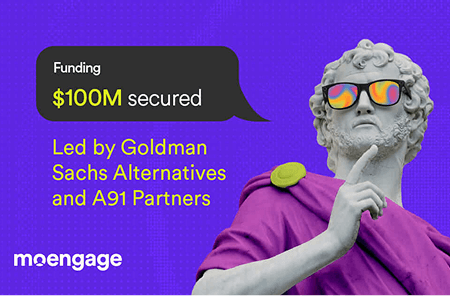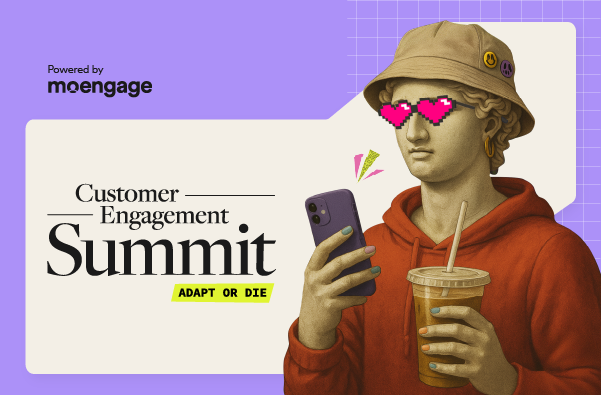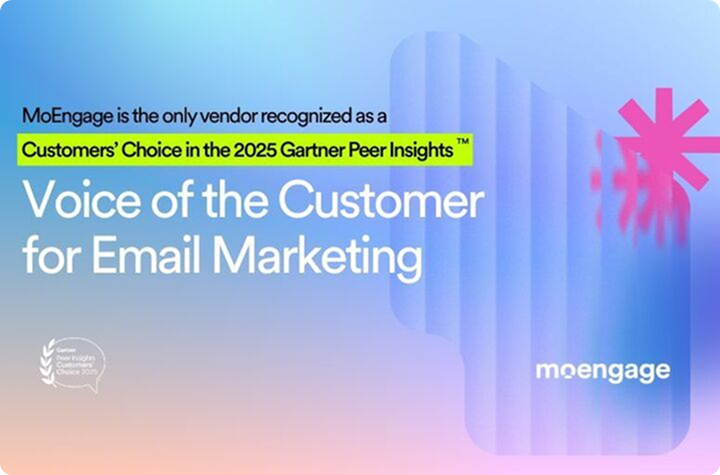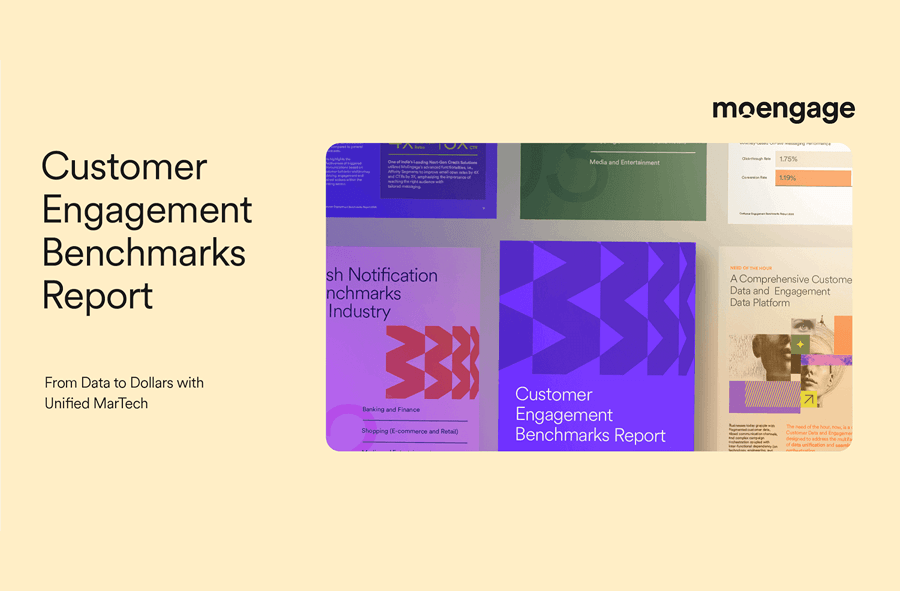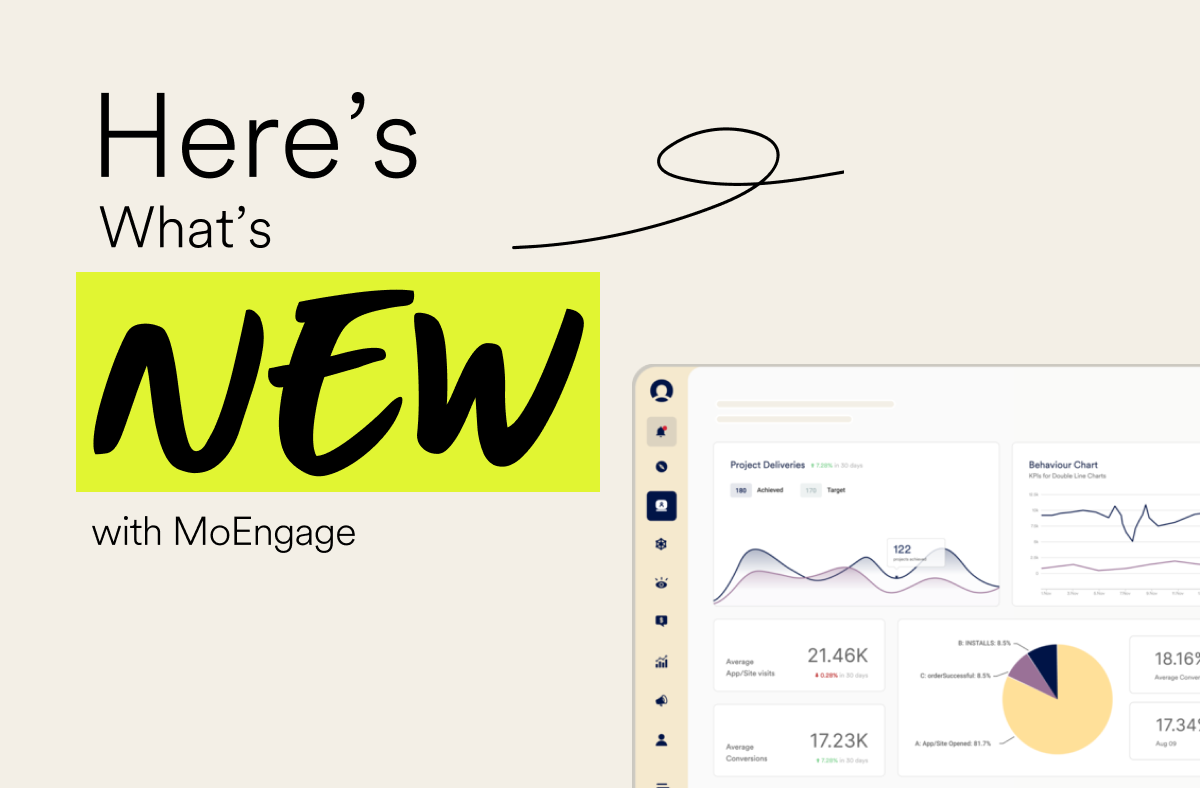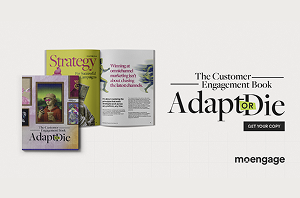34 Email Marketing Best Practices All Marketers Must Follow

Reading Time: 25 minutes
Email marketing works best when it feels personal. When every message lands at the right time and genuinely adds value to the reader. That kind of impact doesn’t happen by chance; it comes from following thoughtful email marketing best practices that shape everything, from how you segment your audience to how you write your subject lines.
Think about the brands whose emails you actually look forward to. They’re not sending more messages — they’re sending smarter ones. Each campaign feels intentional, tested, and aligned with what their audience truly cares about.
In this guide, we’ll break down those best practices into practical areas, such as creative email marketing strategy, deliverability, automation, and testing, so you can create emails that not only perform better but also feel more meaningful to the recipients.
Before we dive into the details, it helps to know the key areas that make email campaigns work.
We’ll cover everything, from understanding your audience and crafting engaging content to ensuring deliverability, testing for better results, and using automation to stay consistent, all essential pieces of effective email marketing.
When applied together, these email marketing best practices can help you create campaigns that are not just efficient but genuinely impactful, delivering the right message to the right person at the right time.
Email Marketing Best Practices for Personalization
Email personalization is what makes customers actually want to open and click your emails. Think about it. Would you rather open those generic ‘Big sale today!’ emails or one that says ‘Hey there, your favorite serum is back in stock and at half off!’?
Case in point: 59% of Americans say that most emails they receive are not useful to them.
Adding to this, MoEngage’s latest Email Marketing Benchmarks Report reveals that customers are 22.6x more likely to click on emails from Retail & E-commerce brands that are personalized based on behavior, and 60.7x more likely to convert, compared to generic broadcast emails.
Done right, personalization plays a key role in improving email opens, CTRs, and even conversions since messages are likely to feel more relevant to the audience.
The trick is to balance relevance with privacy. You need to make sure to use your customer data responsibly and always tie personalization efforts back to clear business goals.
Following some of the below email marketing best practices for personalization ensures that your messages resonate with each recipient rather than being lost in the inbox.
1. Build product recommendations that actually help

Move beyond your typical static “blast” emails. Instead, use your product catalog and customer behavior, like what they viewed, bought, or might need text to auto-generate product recommendations.
Why it matters:
It turns your emails into something useful instead of just another promotional message. Recipients are more likely to click when the content feels personally relevant, which means higher CTRs and revenue per send.
Example:
Let’s say you run an online bookstore. Using email personalization tools, you can identify customers who recently browsed mystery novels, live in Los Angeles, and often buy during weekend promotions. You could automatically send them an email like:
“Hi Katie, these new mystery releases just hit our shelves, and we thought you might enjoy them. Grab your next page-turner this weekend and get 15% off.”
For example, MoEngage’s Customer Insights tool collates all your customer data, from demographics to past purchases to app behavior. It then analyzes all this data and turns it into actionable insights. You can use these insights to create emails that your customers are interested in.
The platform can also figure out the best time to send an email so it lands when the user is most likely to engage. Instead of sending generic emails, each person receives a message that feels relevant and timely, all without you having to manually segment or schedule anything.
2. Send emails based on your customer’s location and context
Emails become more effective when they reflect a recipient’s environment and situation. Using data such as location, local time, and device type, you can tailor messaging to be highly relevant. For example:
- A retail brand can promote in-store events, flash sales, or regional offers to customers in a specific city.
- A travel app can send destination-specific deals based on where the user is currently located.
Why it matters:
When emails match the recipient’s context, they feel helpful instead of generic. People are more likely to open, click, and engage with messages that arrive at the right time and speak to their situation, which ultimately drives higher engagement and revenue. Prioritizing context and relevance in this way is a core principle of email marketing best practices, helping your drip email campaigns consistently deliver value and stronger results.
Example:
To revisit the bookstore example, let’s say you manage both physical stores and an online shop. You could build your email list and then segment it by city and schedule messages to land at times people are most likely to shop. For example:
“Hi Alex, our weekend sale starts today at your local store! Don’t miss these special deals.”
This single, targeted email aligns with the customer’s location and timing, making it feel personal and actionable without requiring manual segmentation for every individual.
3. Tailor emails to customer lifecycle stages
Your customers aren’t all the same. Each customer is at a different point in their journey with your brand. A one-size-fits-all email approach won’t work because what motivates a new subscriber is completely different from what drives a loyal customer to take action. By mapping emails to lifecycle stages, you can deliver content that resonates, engages, and nudges customers toward meaningful actions at the right time.
Why it matters:
Emails that align with a customer’s lifecycle stage feel purposeful and relevant rather than generic noise. In fact, research also shows that out of different email types, behavior-based and journey-based emails are the most effective in delivering results as compared to others.
New subscribers receive guidance and brand context, active users receive helpful nudges to engage further, and dormant or lapsed customers receive incentives to return. This alignment improves open rates, click-throughs, and conversions, and ultimately fosters long-term loyalty.
Many leading companies have recognized this, even reorganizing their teams and messaging around the customer journey to make personalization more strategic. As Megan Kwon, Director of Digital Communications from Loblaw, explains in The Customer Engagement Summit:
Our team actually pays attention to our messaging ecosystem now looking at it from the customer journey. So starting from onboarding and registration, moving over to discovery and engagement, and then we’ve got a pod around shopping and post-purchase. And within that, each pod is actually looking at every business unit within that customer life cycle. And that’s allowed us to be much more proactive and strategic in our approach.
Best Practices for Email Marketing Campaign Segmentation
Segmentation is all about sending the right message to the right people at the right time. A well-segmented email list ensures your content is relevant, boosts engagement, and drives more conversions. This section covers actionable best practices for breaking your audience into meaningful groups, so every email feels personal without being overwhelming.
1. Segment by behavior, not just demographics
Most B2C brands start with demographics like age, gender, or location, but that only gives you part of the picture.
Behavioral segmentation is a customer segmentation strategy that goes further. It looks at what your users actually do, such as what they browse on your website, which products they buy, how they interact with your emails, or how they use your app. Instead of guessing what might interest them, you can let their own actions guide the messaging.
Robbie Freeman, the Director of Strategy at Movable Ink, explains this perfectly:
Consider how to get your customers to do the heavy lifting for you. They’re constantly dropping clues. What are they browsing? What are they buying? What are they ignoring? These are all things that you should be thinking about as you talk to your customers. Even your most basic lifecycle flows, welcome, post-purchase, re-engagement, can feel hyper-relevant if they are built with real-time behavior in mind.
Why it matters:
Two people in the same age group can have completely different interests.
One might be browsing winter jackets while the other is looking at summer dresses. If you send them both the same generic email, chances are it gets ignored or worse — it may even frustrate them.
Segmenting your emails based on behaviour ensures your messages are smarter and more relevant, and those are the kind of emails that get noticed, drive clicks, and increase purchases. They can drive up to 30% more opens and 50% more clickthroughs than unsegmented emails.
Example:
An online fashion retailer could avoid sending a generic “Winter Collection” email to all subscribers. Instead, they could segment customers who browsed winter jackets in the past week and send an email featuring top-selling jackets or a limited-time discount. The email feels timely and personal, increasing the likelihood of engagement and conversions.
2. Segment by engagement levels
Not every subscriber interacts with your emails the same way. Some open and click almost everything you send, while others may only engage occasionally, and some might have gone quiet for weeks.
Understanding how your audience engages with your emails is crucial for sending the right message to the right people.
Why it matters:
Engagement-based segmentation lets you treat different customers according to their behavior. Highly engaged customers get content that keeps them coming back, while less active customers receive nudges that feel relevant without being spammy. This approach improves deliverability, boosts open rates, and increases conversions.
Example:
For example, popular music streaming platform Spotify uses segmentation to keep users engaged and drive Premium subscriptions. They group users based on listening behavior, past engagement, and preferences. New or less active users receive emails highlighting personalized playlists or recommendations, while highly engaged users get updates on new releases and shareable campaigns, like Spotify Wrapped. By tailoring emails to each group, Spotify boosts engagement, click-throughs, and conversion to Premium.
3. Combine multiple data points for micro-segmentation
Micro-segmentation means going beyond simple categories and combining different pieces of information about your audience. You can look at behavior, purchase history, preferences, location, and even the device they use. The goal is to create small, highly specific groups that share a lot in common, so the emails they receive feel like they were made just for them.
Why it matters:
Micro-segmentation allows you to treat each subscriber like an individual instead of just a number on your list. When you combine multiple data points, your emails feel intentionally crafted for each person, not like a generic blast.
This boosts engagement because customers are more likely to open messages that match their interests, lifestyle, or habits. It also improves conversion rates since the content aligns with their current needs or preferences.
On top of that, sending highly relevant emails using email marketing software helps maintain a healthy sender reputation and keeps unsubscribe rates low, because subscribers actually find value in what they receive.
Example:
Imagine you run an online sporting goods store. You know that some of your customers are avid runners who live in San Diego, California, and tend to shop on weekends. By combining these data points, you can create a micro-segment of ‘weekend shoppers who love running and live in San Diego’.
For this group, you could send a personalized email like: “Hi Rebecca, this weekend only, get 20% off our latest running shoes to keep your morning runs on track.”
Because this email combines behavior, location, and shopping habits, it feels highly relevant and timely. Instead of sending the same promotional email to your entire list, each subscriber receives content that truly matches their interests, boosting the chance they’ll engage, click, and purchase.
That said, it’s a fact that segmentation is the path to deeper personalization in every marketing campaign.
Email Marketing Frequency and Timing Best Practices
Sending the right email at the right time can make all the difference in engagement. This category focuses on how often you should reach out to your subscribers and when your emails are most likely to be seen, opened, and acted upon. Doing it well prevents inbox fatigue, keeps your brand top of mind, and ensures your messages land when your audience is most receptive.
1. Find the sweet spot for your email frequency
Email frequency refers to how often you send emails to your subscribers. Too few emails, and your brand may be forgotten. Too many, and you risk annoying your audience, which can lead to unsubscribes or spam complaints.
Why it matters:
Finding the right balance keeps your audience engaged without overwhelming them. Subscribers who feel bombarded are less likely to open emails, while those who hear from you occasionally are more likely to anticipate and engage with your messages.
Example:
For example, a travel company could create an engaging email newsletter about general offers every week. But during a limited-time promotion, MoEngage’s Merlin AI can detect which customers are most likely to engage and send targeted, high-value content only to them, like personalized flight deals or hotel recommendations.
Merlin AI uses machine learning to automatically optimize who receives which content and when, based on real-time interaction patterns. By dynamically adjusting email delivery and content, Merlin AI ensures each customer gets messages that are timely and relevant without overwhelming them.
2. Adjust frequency based on content type and value
Not all emails are equally important. Adjust how often you reach out depending on the value of the content. High-value emails, such as exclusive offers, product launches, or time-sensitive deals, can be sent more frequently. Lower-value content, such as general newsletters or informational updates, should be sent less frequently to avoid overwhelming your audience.
Why it matters:
Subscribers are more likely to engage when every email feels meaningful and relevant. Sending too many low-value emails can annoy customers and trigger unsubscribes, while sending only sporadic high-value emails can mean missed opportunities for conversions. By tailoring the frequency to the importance of the content, your audience stays engaged without feeling bombarded.
Example:
A fitness app might send a weekly email with general wellness tips, but during a new challenge launch, it sends daily emails highlighting workouts, progress updates, and motivational content. Subscribers receive more frequent emails only when they add real value, thereby maintaining high engagement without email fatigue.
3. Align email frequency with seasons and events
Instead of sending emails at a constant pace throughout the year, let real-world events guide your schedule. Seasons, holidays, cultural moments, or even trending topics can give context to your messages and make them feel relevant.
You can increase your email frequency during high-interest periods and dial it back when things are slower. The goal is to match your messaging rhythm with your audience’s natural attention and needs.
Why it matters:
When emails connect to what your audience is experiencing in real life, they feel more timely and thoughtful. Subscribers are more likely to open emails tied to events or seasons that matter to them. Your brand comes across as aware and helpful, rather than generic or just trying to sell. This approach also encourages stronger engagement because the content is immediately useful or exciting.
Example:
For example, a skincare brand could send more frequent emails in the winter with messages focused on ‘winter hydration essentials’ and special discounts on moisturizers.
Around Valentine’s Day or a subscriber’s birthday, the brand might send curated gift ideas or limited-time bundles. Outside these peak moments, the brand could send occasional emails with general skin health tips. By adjusting frequency to match the calendar and audience expectations, each message feels relevant, timely, and valuable.
The crux of the matter is that you should send campaigns after determining the best time to send an email to your customers.
Email Marketing Deliverability Best Practices
Email deliverability is all about making sure your emails actually reach your subscribers’ inboxes, rather than getting lost in spam or promotions folders. Even the most beautifully designed, highly personalized email won’t drive results if it never reaches its audience. This section covers strategies to protect your sender reputation, improve inbox placement, and ensure your emails are seen and engaged with.
1. Maintain a clean and engaged subscriber list
Keeping your email list healthy means regularly checking for subscribers who are no longer engaging. This could be people who haven’t opened or clicked on your emails in months, or addresses that bounce or are no longer valid.
Why it matters:
Internet service providers pay attention to how recipients interact with your emails. If you keep sending messages to inactive or invalid addresses, you risk being flagged as spam. A tidy, engaged list not only improves open rates, it also strengthens your sender reputation and makes sure your emails reach the people who actually want to hear from you.
Example:
Imagine an online store that runs a re-engagement email campaign every few months. They reach out to subscribers who haven’t opened an email in six months with a small incentive like a discount or free shipping. If those customers still don’t engage, they are removed from the main list.
This way, the store focuses on the audience that actually interacts with their emails, keeping engagement high and deliverability strong.
2. Monitor content and sending patterns to avoid spam triggers
Spam filters aren’t random. Certain words, phrases, or formatting choices can make your emails look suspicious, and sudden changes in your sending patterns or big jumps in email volume can raise red flags with ISPs. Before you know it, you’ll find yourself struggling to fix your email sender reputation.
Keeping an eye on both the content you send and how you send it helps ensure your emails actually reach the inbox.
Why it matters:
Even if your subscribers love your content, they won’t see it if it gets trapped in spam. Avoiding common spam triggers and maintaining a steady, predictable sending rhythm not only improves deliverability but also builds trust with ISPs, making all your future campaigns more likely to land where they belong – in customers’ inboxes.
That’s how Rain increased email deliverability by 3X.
Email Marketing Subject Line Best Practices
Your subject line is the very first impression your email makes, and it often decides whether someone opens your message or scrolls past it. A great subject line does more than grab attention—it quickly communicates what the subscriber will gain, sets clear expectations, and sparks enough curiosity for them to click. So if you want to know how to increase your email open rates, this is the place to start.
This section will walk you through practical strategies to craft email subject lines that don’t just get opens, but also strengthen the connection with your audience. You’ll learn how to balance clarity and creativity, make your emails feel personal and timely, and ultimately drive higher email engagement and conversions.
1. Be clear and specific about the value
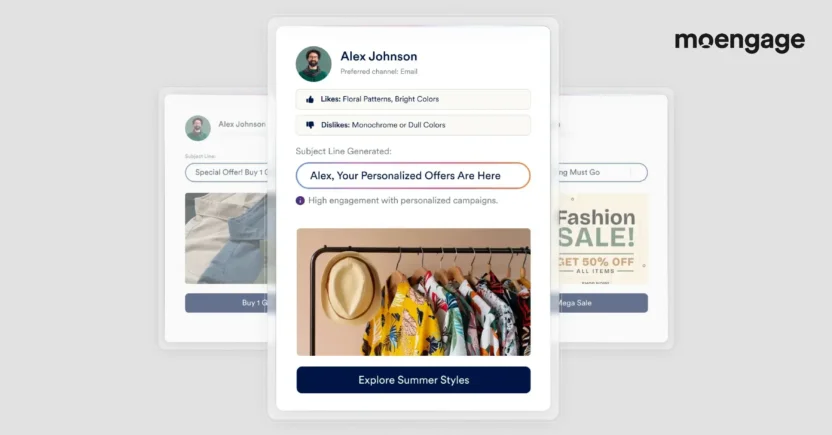
A good subject line doesn’t need to be mysterious or packed with buzzwords. The best ones are simple, clear, and instantly tell your reader what they’ll get from opening your email.
Think of it as setting a small but honest expectation. You’re letting subscribers know exactly why this email is worth their time.
A tool like MoEngage’s Merlin AI Copywriter makes this process easier by generating optimized subject line options tailored to your campaign’s goal. You can:
- Describe your campaign intent, audience, and tone.
- Pull in high-performing keywords that have worked for your brand before.
- Exclude overused or low-performing phrases that may hurt engagement.
- Instantly test AI-generated variants through A/B testing to see what resonates best.
Why it matters:
People are busy, and their inboxes are crowded. In fact, nearly 40% of consumers say that they have at least 50 unread emails in their inbox.
When your subject line clearly explains what’s inside, it helps you stand out for the right reasons. Readers are more likely to click because they know what to expect. Over time, this kind of honesty builds trust and keeps engagement steady. On the flip side, vague or clickbaity subject lines might get attention once, but they quickly erode credibility.
2. Personalize subject lines to increase relevance
Personalization in subject lines is one of the most effective email marketing best practices you can use to reach the average email open rate of 28.6%. It’s about making your emails feel like they were written for each person, not just for your entire list. And it goes beyond adding a first name.
You can reference what someone recently browsed, a product they purchased, or even their location or upcoming local events. The goal is to show that you understand what matters to them.
Why it matters:
People receive dozens of emails every day, and most of them look similar at first glance. When a subject line feels personal or familiar, it stands out. It’s the difference between saying “Hey, everyone” and saying “Hey, I found something you might love.” Over time, this sense of relevance helps build trust and makes your audience more likely to open your emails again and again.
Example:
A clothing store could send a message like, “Emma, these jackets match your winter wishlist.” This instantly feels personal and specific, as if the brand remembered what Emma was looking at. Compare that to a generic subject line like “Winter Jackets Are Here.” The first one feels like a thoughtful recommendation, while the second feels like a mass promotion.
3. Create curiosity without misleading
Curiosity is a powerful tool in your subject line strategy. A well-written line can make people pause and think, “I need to know more.” The key is to spark that interest while staying honest about what’s inside your email. A good subject line teases the content just enough to draw readers in, without crossing into clickbait territory.
Why it matters:
Creating intrigue is great for open rates, but misleading subject lines can quickly erode trust. Once subscribers realize the content doesn’t match the promise, they’re less likely to open future emails or may even unsubscribe.
One of the easiest email marketing subject line best practices to follow is to check out the best email subject lines that boost open rates.
Email Marketing Automation Best Practices
Marketing automation lets you deliver the right message to the right person at the right time without manual effort. Done well, it improves engagement and conversions and saves your team hours of repetitive work. This section covers actionable email marketing automation best practices and strategies for making the most of your automated email marketing campaigns.
1. Automate timely, trigger-based campaigns
Trigger-based automation involves sending emails when a customer takes a specific action or reaches a certain milestone. This could be signing up for your service, leaving items in a shopping cart, browsing certain product categories, or completing a purchase. The key is that these emails are automatically sent in response to real customer behavior rather than at a generic time.
Why it matters:
Timing is everything in email marketing. Messages that arrive when they are most relevant feel helpful instead of intrusive. Triggered campaigns often achieve higher open and click rates because they respond directly to a customer’s intent in real-time. Compared to batch campaigns sent to your whole list, trigger-based emails are more likely to convert because they match the customer’s immediate interest.
2. Leverage AI and machine learning for optimization
Modern marketing automation software platforms use AI and machine learning to make your campaigns smarter. They can predict the best time to send an email, suggest content that resonates with each customer, and identify which subscribers are most likely to engage. This goes beyond simple segmentation and rules, letting your emails feel personal and timely at scale.
Why it matters:
Relying solely on manual scheduling and guesswork can leave engagement on the table. As one of the best practices for email marketing, AI-driven automation helps ensure that your emails reach the right people at the right time, with content that matters to them. This not only improves open and click-through rates but also strengthens your overall ROI and builds trust with your audience.
Example:
A travel company using MoEngage’s Merlin AI sets up automated emails that offer personalized deals exactly when a customer is most likely to book. For example, if a customer frequently browses weekend getaways, Merlin AI predicts the optimal time to send a deal for a nearby destination. The emails arrive when the subscriber is ready to take action, leading to higher bookings compared to generic batch campaigns.
3. Build automated nurture sequences
Nurture sequences are a series of automated emails that guide customers through a specific journey. This could be onboarding new customers, educating customers about your product, or re-engaging inactive subscribers. Each email builds on the previous one, creating a cohesive experience that helps your audience take the next step.
Why it matters:
Consistency is key when it comes to engagement. Automated sequences allow you to stay in front of customers without manually sending each email. Over time, these sequences build trust, show value, and gently guide customers toward conversion. They keep your brand memorable while delivering relevant information exactly when customers need it.
Conducting Customer Journey Orchestration in Email Marketing
Customer journey orchestration is about mapping the entire customer experience with your brand and delivering relevant emails at every stage. It goes beyond sending isolated campaigns and instead focuses on creating a seamless, personalized experience. The goal is to guide customers naturally through awareness, consideration, conversion, and retention with messages that feel timely and meaningful.
1. Map the entire customer journey
Mapping the customer journey means understanding every step your customers take with your brand, from their first touchpoint to becoming a loyal customer. This is about every interaction across email, push notifications, SMS, in-app messages, WhatsApp, and more. By mapping this journey from scratch or using customer journey map templates, you can anticipate customer needs and deliver emails that feel timely, relevant, and helpful.
Why it matters:
When emails are tied to where a user actually is in their journey, they don’t feel random or spammy. Instead, they feel personal and useful, which builds trust, increases engagement, and drives conversions. According to MoEngage’s research, irrelevant messages frustrate over 12% of consumers enough that they switch brands. Creating a customer journey map helps avoid that.
2. Use customer journey insights to fix pain points
Customer journey mapping reveals exactly where subscribers engage, hesitate, or drop off in their interactions with your brand. Translating these insights into email marketing helps you design emails that address friction, highlight opportunities, and nudge customers along the journey.
Why it matters:
Emails sent without insight into the subscriber’s current stage or pain points often get ignored. When you align content with where a customer is in their journey, open rates, click-throughs, and conversions improve because the message feels relevant, timely, and helpful.
3. Leverage journey automation for smarter segmentation

Customer journey automation is about understanding the full path your subscriber takes with your brand and using that information to send the right email at the right time. Instead of sending the same message to everyone, you map out different omnichannel customer journeys based on behavior, preferences, and past interactions, and automate messages that guide them toward meaningful actions.
Why it matters:
Subscribers are more likely to engage with emails that feel personal and relevant to what they are doing or thinking in that moment. By automating customer journeys, you can anticipate needs, prevent drop-offs, and create a smoother, more personalized customer experience that builds trust and loyalty over time
Example:
Imagine a customer browses products but does not make a purchase. Instead of sending a generic follow-up, you trigger a sequence of emails based on their actions. The first email reminds them of what they viewed, the next suggests complementary products, and a later email offers a small incentive if they have not made a purchase yet. This approach increases open rates and conversions compared to sending a standard promotional email to all customers.
Email Marketing Design and Layout Best Practices
Creating emails that not only look good but also drive action is essential for modern marketers. This category covers email design best practices and strategies to make your emails visually appealing, easy to read, and highly engaging, while ensuring your design supports your marketing goals.
1. Keep your design clean and scannable

A clean, uncluttered design ensures your emails are easy to read and navigate. Use short paragraphs, bullet points, and clear headings so subscribers can quickly scan and understand your message. Limit the number of images and links to avoid overwhelming the reader, and use whitespace strategically to separate sections and highlight your call-to-action.
Why it matters:
When your email is scannable, subscribers can quickly grasp your message and are more likely to engage with your content. Reducing visual clutter lowers cognitive load, making it easier for readers to focus on your offers and take action.
2. Prioritize mobile-first design
Most emails are now opened on smartphones or tablets, so it is essential to design with mobile users in mind first.
Mobile-first design ensures your emails look great on smaller screens, load quickly, and are easy to navigate. Use responsive email marketing templates that automatically adjust layouts, include larger buttons for touch interactions, and keep content concise so subscribers can digest it without scrolling excessively.
Why it matters:
Mobile-optimized emails provide a smoother experience, reduce accidental clicks, and drive higher engagement. Subscribers are more likely to read, click, and convert when emails are easy to interact with on their preferred devices.
3. Use dynamic content to make emails more relevant
Dynamic content personalization allows you to change sections of your email based on subscriber behavior, preferences, or demographics. Instead of sending the same static email to everyone, you can personalize headlines, images, offers, and calls-to-action to match each recipient’s interests.
Why it matters:
Personalized emails boost engagement by showing subscribers content that feels tailored to them. They are more likely to open, click, and convert when the content speaks directly to their needs or past interactions.
Example:
For instance, a retail brand could show different product recommendations to subscribers based on their browsing history. Someone who recently viewed shoes would see footwear options in the email, while another subscriber who explored handbags sees curated bag selections instead. This approach of email personalization in Ecommerce and other industries keeps emails relevant and increases the chances of purchase.
Read More: The ultimate guide to email design best practices for marketers
4. Use clear and compelling headers
Your email headers are the first thing readers notice, both in the inbox (subject line and preheader) and within the email itself. A strong header guides the reader, sets expectations, and draws attention to the main message. Keep headers concise, descriptive, and aligned with the content below, in keeping with email marketing header best practices.
Why it matters:
Clear headers make it easier for subscribers to scan and understand your email at a glance. They increase engagement by highlighting the value of the message and improving comprehension, which ultimately supports higher click-through and conversion rates.
Example:
Let’s take a retail email:
- Subject line: “Your Weekend Favorites Are Here – 20% Off!”
- Preheader: “Hurry, sale ends Sunday at midnight.”
- In-email header: “Top Picks Just for You”
Why does it work? The subject line grabs attention with urgency and personalization, the preheader reinforces the offer, and the in-email header directs the reader immediately to the main message.
5. Include a clear and functional footer
The footer of your email is more than just a place for legal disclaimers. It provides an opportunity to build trust with your audience, offer additional navigation, and give subscribers control over their email preferences.
As per email marketing footer best practices, including clear links to unsubscribe, manage preferences, or access support makes your emails feel professional and respectful of your readers’ choices. You can also use the footer to highlight social media profiles, privacy policies, or other helpful resources.
Why it matters:
A well-crafted footer enhances the reader’s experience by providing easy access to essential information and options. It builds trust, reduces frustration, and ensures compliance with email regulations. Clear footer navigation also encourages further engagement with your brand by pointing readers to additional content or support.
6. Use strong, actionable CTAs
The call-to-action is the heart of your email. It tells your subscribers exactly what you want them to do next, whether it’s making a purchase, signing up for an event, or reading more content. Following email marketing layout best practices, a strong CTA should be visually distinct, clearly worded, and placed strategically within your email so that it’s easy to notice and click.
Using action-oriented language, such as “Shop Now,” “Get Your Discount,” or “Start Your Free Trial,” helps remove ambiguity and drives engagement. You can also experiment with button size, color, and placement to see what performs best for your audience.
Why it matters:
A clear and compelling CTA makes it easy for subscribers to take the desired action. According to recent research, using a specific, clear CTA can increase conversion rates by 161%. Personalized CTAs perform even better, with 202 percent higher engagement than generic buttons.
Incorporating these strategies is a key part of email marketing best practices, ensuring your emails not only look great but also drive measurable results and effectively move subscribers through the marketing funnel.
Best Practices for Email Marketing Content, Images, and Video
With the advent of Gmail’s ‘Manage subscriptions’ tool, subscribers can already mass unsubscribe from emails that don’t resonate with them. Hence, the content in your emails is what ultimately drives engagement and conversions.
This section covers best practices for crafting compelling copy, using visuals effectively, and incorporating video to make your emails more interactive. Following these strategies and best practices for email marketing content ensures your messages capture attention, communicate value, and inspire action.
1. Prioritize concise, benefit-driven copy
Your email copy should be direct and clearly communicate the value to your reader. Instead of simply listing product features, focus on the benefits your subscribers will gain from using the product.
Keep your sentences short, break up content with bullet points, and avoid adding fluff that distracts from your key message. Every word should serve a purpose and help your reader understand why they should care.
Why it matters:
Customers often skim emails rather than reading them carefully. Long paragraphs or vague messaging can make it hard for readers to understand the value quickly. When your copy is concise and benefit-focused, it becomes easier to digest and encourages the reader to take action. Clear messaging helps boost click-through rates and keeps your subscribers engaged over time.
Example:
A productivity app could send an email with the subject line, “Boost Your Focus in 10 Minutes a Day.” Instead of explaining every feature in detail, the body could list three simple, actionable tips for using the app. Readers immediately understand the value they will get and are more likely to engage, click, and take action.
2. Preview and test your emails across devices and spam filters
Before hitting send, it’s crucial to check how your email looks on different devices and ensure it avoids spam filters. This includes previewing emails on smartphones, tablets, and desktops, as well as scanning for elements that might trigger spam detection.
MoEngage’s email preview feature allows you to test emails across multiple devices and browsers in one place, giving you confidence that your subscribers will see your email exactly as intended.
Why it matters:
Most subscribers read emails on mobile devices, and a misaligned email can frustrate users and reduce engagement. Similarly, ending up in the spam folder can mean your carefully crafted email never reaches your audience. Testing helps maintain professionalism, improves click-through rates, and maximizes deliverability.
3. Add interactive elements to boost engagement
Interactive elements, such as GIFs, carousels, accordions, or clickable product tiles, allow subscribers to engage directly within the email. These features create a more dynamic experience and can highlight multiple products or messages in a single email.
Why it matters:
Interactive content grabs attention, encourages clicks, and keeps readers engaged longer. It’s a great way to showcase multiple offers without cluttering the email and can increase conversions by making the experience more engaging.
Example:
An Ecommerce brand uses a carousel in its email to showcase five new arrivals. Subscribers can click through the carousel images directly in the email to view different products, without leaving the inbox. This drives higher engagement and click-through rates compared to a static single-image email.
Email Marketing Mobile Best Practices
With nearly half of smartphone users (46%) preferring to receive communications from brands through email, optimizing for mobile has never been more important. This category covers email marketing mobile best practices and strategies to make your emails easy-to-read, engaging, and actionable on smartphones and tablets, ensuring your messages reach customers where they are most active.
1. Design mobile-first emails
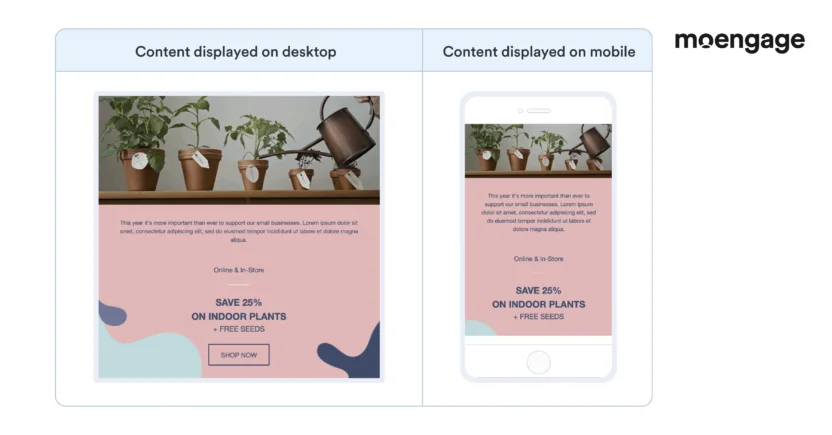
Mobile-first design means creating your emails with smartphones as the primary viewing device. This approach ensures your content is easy to read, navigate, and interact with on smaller screens.
Key elements include single-column layouts, legible fonts, touch-friendly buttons, and concise, scannable copy. Every design choice should consider how it looks and feels on a mobile device before scaling up to a desktop.
Why it matters:
The majority of customers now check emails on their phones, often while on the go. Emails that are too wide, hard to read, or have tiny links frustrate users and can lead to unsubscribes or low engagement. A mobile-first approach improves readability, keeps your audience engaged, and makes it easier for them to take action. Emails that look great on mobile also build trust and professionalism, encouraging higher click-through rates and conversions.
2. Use interactive AMP emails to improve mobile engagement
AMP (Accelerated Mobile Pages) emails allow users to interact directly within the email on their smartphone. Instead of clicking a link and navigating to a website, customers can fill forms, browse products, schedule appointments, or complete surveys right inside the email. This creates a seamless, mobile-first experience.
Why it matters:
Mobile users often abandon emails that require switching apps or web pages. Interactive AMP emails remove this friction, making it easier for users to take action instantly. Since 46% of smartphone users prefer receiving communications via email, optimizing emails for mobile interaction can significantly increase mobile customer engagement and conversions.
3. Prioritize fast-loading, lightweight emails
Mobile users often check emails on slower networks or while on the go. Large images, heavy GIFs, or videos can delay loading, frustrate readers, and increase the likelihood of them abandoning your email before seeing your message. Creating lightweight emails means:
- Compressing images without sacrificing quality using formats like JPEG or WebP.
- Using GIFs or linking to video content hosted elsewhere.
- Limiting the number of images and heavy design elements to only what is essential.
- Keeping your total email size under 1MB whenever possible ensures faster load times.
Why it matters:
Every second counts on mobile. Slow-loading emails reduce engagement, lower click-through rates, and can harm your brand perception. Lightweight emails deliver a smoother experience, keep readers engaged, and ensure your content reaches the audience as intended.
Email Marketing Campaign Reporting And Analytics Best Practices
Effective reporting and analytics on email marketing dashboards help you understand how your email campaigns perform, identify areas of improvement, and make data-driven decisions for future campaigns. By tracking the right metrics, marketers can optimize messaging, timing, and audience targeting to maximize engagement and ROI.
For instance, MoEngage’s email marketing statistics show that the average email conversion rate is 21.26% for the banking and financial services industry, 12.18% for the media and entertainment industry, and just 2.68% for the retail and Ecommerce industry.
1. Track key email metrics consistently
Tracking performance means paying close attention to email marketing metrics that show how subscribers interact with your emails. These include open rates, click-through rates, conversion rates, bounce rates, and unsubscribe rates. Regularly monitoring these numbers helps you understand patterns in engagement, spot potential issues, and measure the real impact of your campaigns.
Why it matters:
If you don’t track metrics consistently, it’s like sending emails blindly. You won’t know what’s resonating with your audience or what’s falling flat. By analyzing these numbers using email analytics tools, you can make data-driven decisions, refine your content, optimize sending times, and improve engagement over time. This prevents you from repeating ineffective strategies and helps you continuously increase ROI.
2. Leverage predictive analytics to predict subscriber behavior
Predictive analytics looks at past subscriber data to forecast future actions, like who is likely to open emails, click on links, or make a purchase.
You can use predictive scoring to automatically segment subscribers based on likelihood to engage or convert. Combine predictive insights with personalized content to make each message feel purposeful and timely. Finally, monitor the performance of these predictive campaigns to continuously refine your models and improve targeting.
Tools like MoEngage Predictions can automatically score subscribers and categorize them into high, medium, or low likelihood to engage or convert. This helps you focus your efforts on the users who matter most.
Why it matters:
Knowing which subscribers are most likely to act lets you deliver relevant and timely emails. Targeted campaigns reduce wasted sends, improve engagement, and increase ROI. Instead of sending the same message to everyone, you can craft communications that speak directly to each user’s predicted behavior.
Example:
An Ecommerce brand uses predictive analytics to identify customers at risk of churning. They send a personalized customer retention email with a special offer to that group. At the same time, highly engaged users get new product recommendations tailored to their interests. Both groups receive relevant content, increasing conversions without overwhelming anyone with irrelevant emails.
Follow Email Marketing Best Practices for Successful Campaigns
The right email marketing strategy goes beyond sending messages—it’s about connecting with your customers personally, driving engagement, and delivering measurable results.
With MoEngage, you can create hyper-personalized campaigns, automate workflows, and track performance in real time, all from a single platform. Explore how MoEngage’s email marketing platform helps leading brands craft engaging customer journeys, and request a demo to see it in action.

